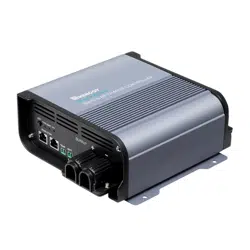Loading ...
Loading ...
Loading ...

28
ON 0.1
second,
OFF 0.1
second,
cycle is
0.2
seconds
2.Use a multi-meter to verify the correct positive and
negative polarity matches the polarity seen on the
OUTPUT port.
Use extra caution when connecting to Lithium
batteries. Reverse polarity protection is valid
unless there’s PV input source connected.
_
Battery
Overvoltage
Quick
Flashing
ON 0.1
second,
OFF 0.1
second,
cycle is
0.2
seconds
Quick
Flashing
_ _
Battery
Open
Circuit
The battery is charging at a higher rate than the
system voltage. The controller has stopped
charging utilizing the electronic protection.
1.Use a multi-meter to read the battery charging
voltage and verify the voltage is within the battery
charging parameters seen in Technical Specifications
– Battery Charging for your respective type.
2.Verify the correct battery voltage for Non-lithium
batteries or verify the correct TYPE LED for LFP batteries.
3.Toggle the controller by disconnecting and
reconnecting the battery to verify the proper system
voltage (36V/48V).
4.Check your solar panel input. Use a multi-meter to
check that the incoming voltage is within 15 ~ 40V.
If this is a 36V system, the PV voltage should not
exceed 15 ~ 25VDC
The battery has unexpectedly disconnected from the
controller with active PV power running, no damage to
the controller despite PV running with no battery bank.
_
Battery
Over-temp
erature
The battery is in an environment where it is
over-heating via utilizing the default 77° F /25°C or
directly observed if using a temperature sensor. In
addition, this could indicate the battery s outside the
normal operating range of -31°F/ -35℃ ~ 149°F /+ 65℃
1.If Battery temperature is above the -31°F/ -35℃ ~
149°F /+ 65℃ range, the controller will stop
charging and only resume charging when the
temperature is within the range again.
2.Place the controller in a ventilated area or add
ventilation to your setup to rapidly cool the
controller.
1.Use a multi-meter to verify proper connections to the
OUTPUT battery terminal. Upon successful connection,
the controller will resume normal charging.
2.If you are using a fuse, double check the fuse to
make sure it has not been compromised.
CAUTION
Loading ...
Loading ...
Loading ...
